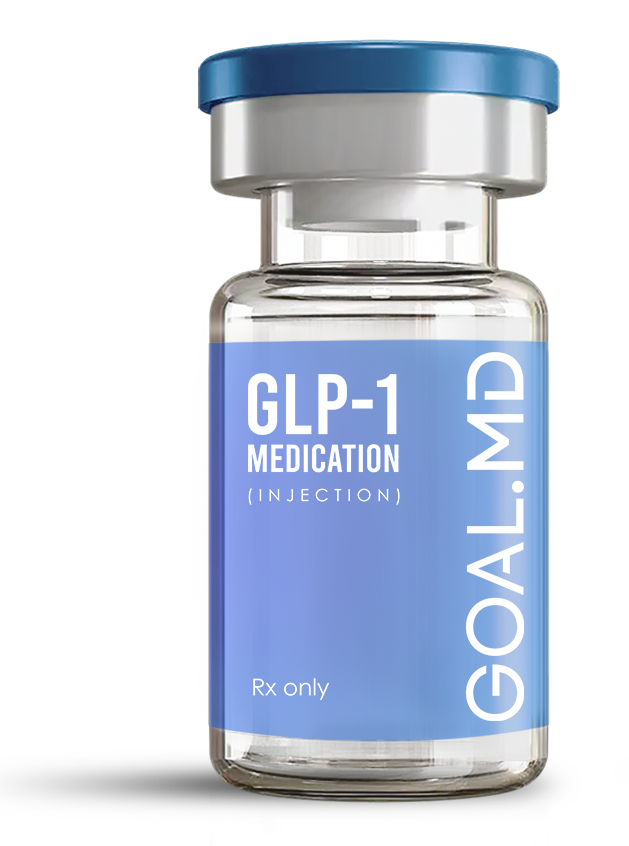
GOAL.MD Health & Wellness Blog
Evidence-based insights, medical weight loss information, and practical tips from our physicians and healthcare experts.

Alcohol and GLP-1'S: What You Should Know Before Mixing the Two
Alcohol and GLP-1: What You Should Know Before Mixing the Two
If you’re on GLP-1s for weight loss or blood sugar support, you may be wondering if that glass of wine or beer is still okay. Here’s everything you need to know about how alcohol interacts with GLP-1 medications and what to consider before mixing the two.
Key Points at a Glance
Alcohol doesn’t directly interact with GLP-1s, but both affect blood sugar and digestion.
Combining the two may increase the risk of side effects like nausea or low blood sugar.
Heavy alcohol use may counteract your weight loss goals and strain your liver.
Some users report reduced alcohol cravings while on GLP-1s.
It’s best to discuss alcohol use with your provider for a personalized safety plan.
Understanding GLP-1s and Their Purpose
Semaglutide is a GLP-1 receptor agonist, designed to help manage blood sugar, reduce appetite, and support weight loss. It mimics a natural hormone that:
Boosts insulin production
Slows digestion
Reduces appetite and cravings
It’s available under names like Ozempic®, Wegovy®, and as compounded GLP-1s through licensed providers. GLP1 has helped many individuals lose weight and improve their metabolic health when paired with healthy eating and physical activity.
Alcohol & Weight Management: The Hidden Cost
Even before GLP-1's enters the picture, alcohol itself can get in the way of your weight loss efforts:
High in empty calories (e.g., beer, wine, and cocktails)
Lowers inhibitions, often leading to poor food choices
Slows metabolism while your body prioritizes processing the alcohol
For example: A margarita can pack over 300 calories, and a night of social drinking can quickly exceed 1,000+ calories without you realizing it.
Alcohol can also interfere with sleep and hormone regulation—two other factors that influence appetite and fat storage.
What Happens If You Drink While on GLP-1's?
While there’s no strict rule that bans alcohol during GLP-1 treatment, there are several important considerations:
1. Increased Risk of Hypoglycemia
Both GLP1 and alcohol lower blood sugar levels. If you're also taking insulin or other antidiabetic medications, this stacked effect can increase your risk of hypoglycemia (low blood sugar).
Symptoms like dizziness, confusion, and shakiness may be mistaken for drunkenness—or go unnoticed entirely.
2. Amplified GI Side Effects
GLP-1 is known to cause:
Nausea
Vomiting
Reflux
Diarrhea
Alcohol can irritate the stomach lining and trigger similar symptoms. When combined, these side effects may become more intense.
3. Liver Considerations
Both alcohol and GLP1 are metabolized in part by the liver. Excessive alcohol can overburden the liver, potentially affecting how GLP-1 is processed.
Can GLP-1's Affect Alcohol Cravings?
Interestingly, some users report a natural decrease in alcohol cravings while on GLP1. This may be due to GLP-1’s influence on the brain’s reward center, which plays a role in food and substance cravings.
While research into GLP-1's for alcohol use disorder is still early, anecdotal evidence points to a reduced desire for high-reward behaviors like overeating and drinking.
Still, GLP1 is not approved to treat alcohol addiction.
How to Drink Safely (If You Choose To)
If you do drink alcohol while taking GLP-1s, here are some safety guidelines to follow:
Don’t drink on an empty stomach — eat a balanced meal beforehand
Limit consumption to 1 drink/day (women) or 2 drinks/day (men)
Stay hydrated between alcoholic beverages
Avoid sugary cocktails that spike glucose and calories
Monitor your body for nausea, dizziness, or changes in blood sugar
Always have a backup plan: Keep glucose tablets or juice on hand if you’re prone to dips in blood sugar.
Alcohol Alternatives That Support Your Goals
Looking to skip the alcohol altogether? You’re not alone. Many GLP-1 users report a renewed focus on their health and are cutting back on alcohol as part of their journey.
Try these instead:
Sparkling water with lime or fruit
Kombucha (watch sugar content)
Herbal teas or flavored waters
Mocktails using fresh herbs, citrus, or cucumber
These options offer a social drink experience without the crash.
When to Talk to Your Healthcare Provider
You should always check with your doctor before combining alcohol with GLP-1's, especially if you:
Have diabetes or prediabetes
Take insulin or sulfonylureas
Have a history of liver issues, pancreatitis, or alcohol misuse
Experience ongoing side effects like nausea, fatigue, or appetite suppression
Your provider can help you assess:
Safe drinking limits
Whether alcohol is worth the risk based on your current health
How to manage potential interactions with other meds
The Bottom Line
GLP1 is a powerful ally in weight loss and blood sugar control—but alcohol can blur the line between progress and setback. While occasional moderate drinking isn’t forbidden, it's essential to consider your goals, side effects, and overall health picture.
Think of GLP-1 as your reset button. Pairing it with supportive habits like clean eating, movement, and mindful drinking (or skipping alcohol altogether) can elevate your results.
Looking to Maximize Your GLP-1's Results?
At GOAL.MD, we offer:
GLP-1's starting at $297/month
Direct-to-door delivery
Physician-guided weight loss plans
Explore pricing and treatment options
Disclaimer: This article is for informational purposes only and does not substitute professional medical advice. Please consult a healthcare provider before making any changes to your medication, diet, or alcohol use.
Why GOAL.MD?
✅ Sourced from audited 503a US compounding pharmacies.
✅ Custom dosages adjusted to your needs.
✅ Free consultation + 24/7 support.

How It Works
1. Quiz
90 seconds. No commitment.
2. Consult
Video chat with your GOAL.MD doctor.
3. Deliver
Meds at your door tomorrow.
Transform Your Life with Physician-Directed Care
Join thousands who've found success with physician-directed care. Take our 3-minute quiz to see if medical weight loss is right for you.








